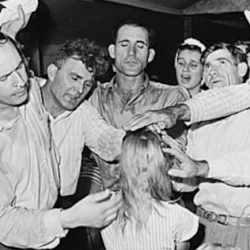Morris Davis’s The Methodist Unification is a study of the reunion of the Methodist church following the Civil War. Davis pays specific attention to the racial politics of the reunion, which formed a black-only national conference, segregated from the white churches. Davis interprets this move against the broad background of American Methodism, adopting Russell Richey’s taxonomy of four Methodist “languages”: popular or evangelical; Wesleyan; Episcopal or Anglican; and republican.
Crucially, Davis argues, the last of these became the dominant language of Methodism in the mid-nineteenth century: “Methodists, particularly in the north in the Methodist Episcopal Church, had almost completely conflated the nation and the church. The ‘republican’ language of Methodism, which mirrored a view of the world in which, among other things, ‘the fate of the republic . . . rested with the virtue corruption of its citizens,’ came to be the dominant language.” He is not concerned with the particulars, but with “the basic move that this dominance entailed: that the fates of the church and the nation were one, and it was the job of the church to ensure that the American nation remained the ‘primary custodian,’ as one historian has put it, of ‘Christian Civilization’ (8).
He thus ties together “two common threads of Methodist history that are normally told separately: its dramatic shift from a largely rural, working-class, countercultural spiritual movement to a mainstream, male-dominated, politically powerful, wealthy national Christian church, and a second dramatic shift from an officially antislavery church to a movement that split along racial lines, comforted slaveowners, and after Emancipation continued to draw sharper lines of racial segregation between white and black Americans.” He argues that “American Christian nationalism and deeply embedded cultural racialism are inseparable. . . . I hope to show through this narrow slice of Methodist history the ways in which the language of race is both a sign of and an integral presence in the broader, more public, and more pervasive language of Christian nationalism. Notably, the contest for ‘nation’ and ‘civilization’ was pervasive among black and white Christians” (8).
This “conflation” of church and nation was accompanied by a blurring of national mission with race. Methodists took up the cause of extending Christian civilization, which was, in practice, equivalent to extending Anglo-Saxon civilization: “just as the broader national narrative of power was more explicitly tied to the language of divine destiny, so was the consolidation of white power articulated in Christian terms. As broad forms of increasing American economic and military power were interpreted as signs of God’s approval, so too did those white Americans who wielded most of that power come to describe its acquisition in terms of divine destiny. Whiteness emerged more concretely into American culture as the primary marker of the pinnacle of human progress—American Christian Civilization—and the Christian churches, in both North and South, played a central role in that emergence. In the church and in the rest of America, Christian civilization was nationalized and racialized” (132).














